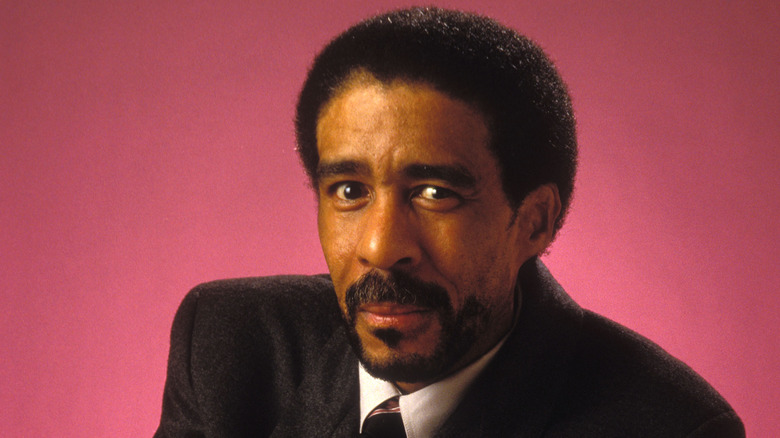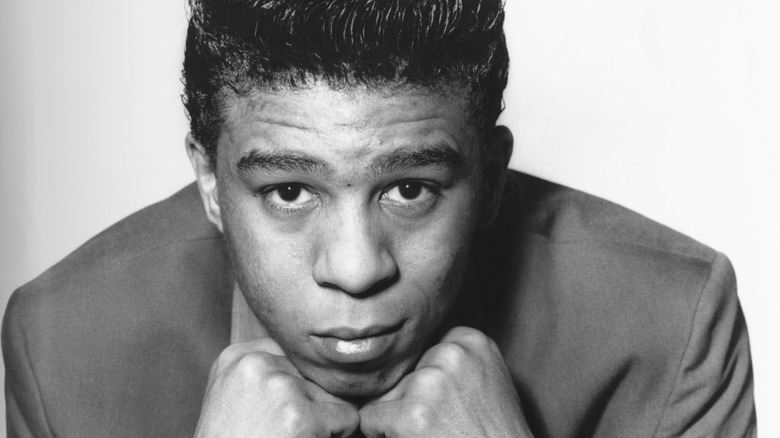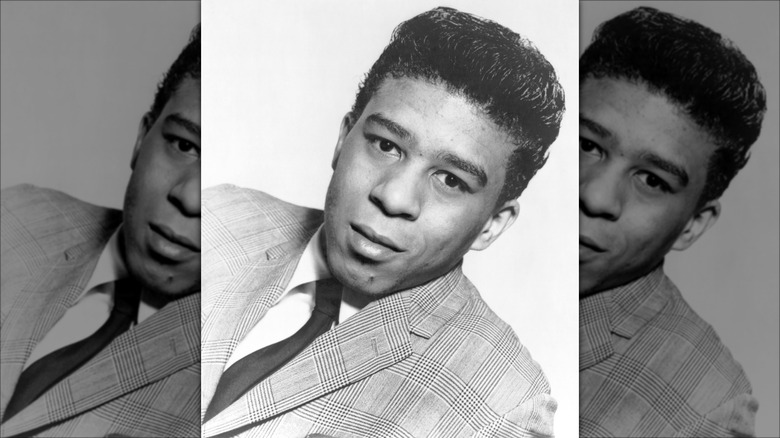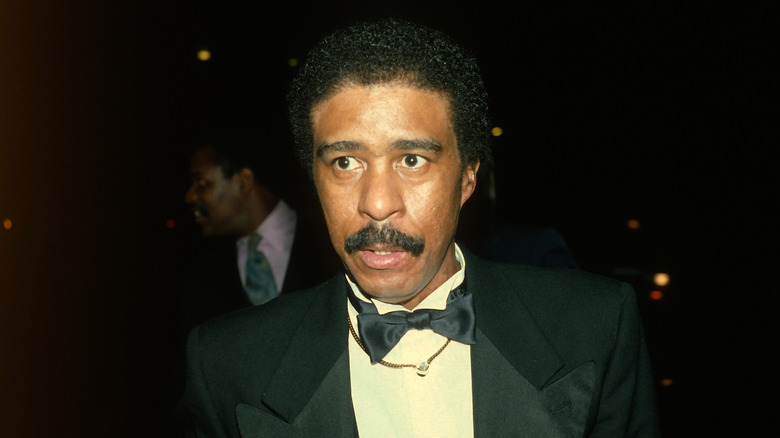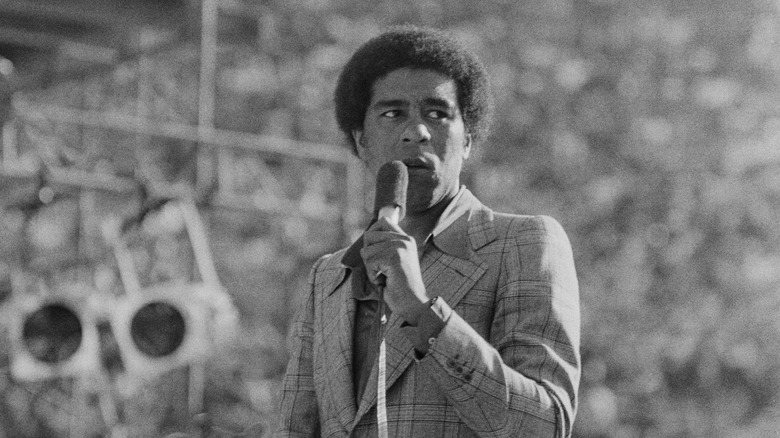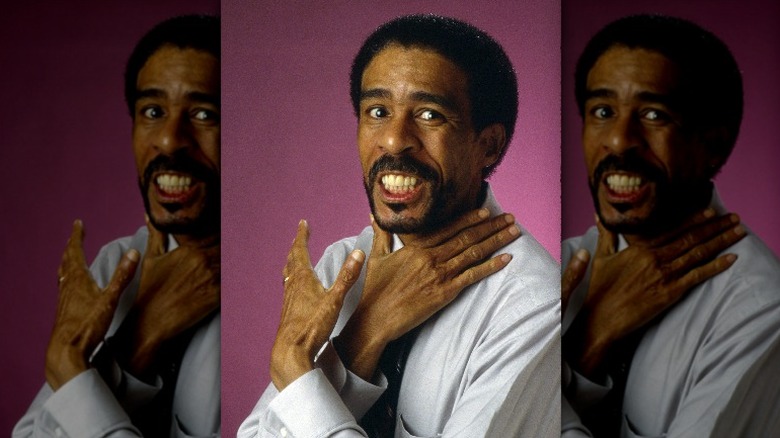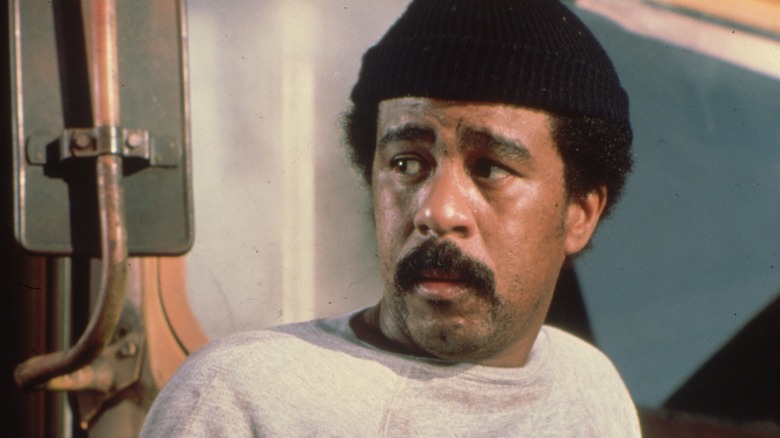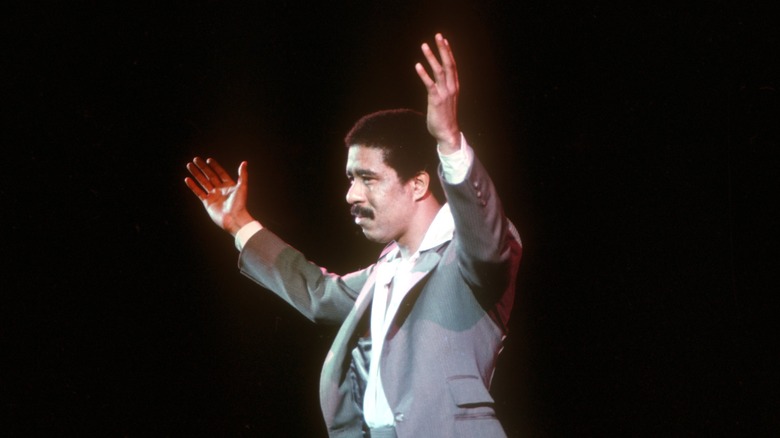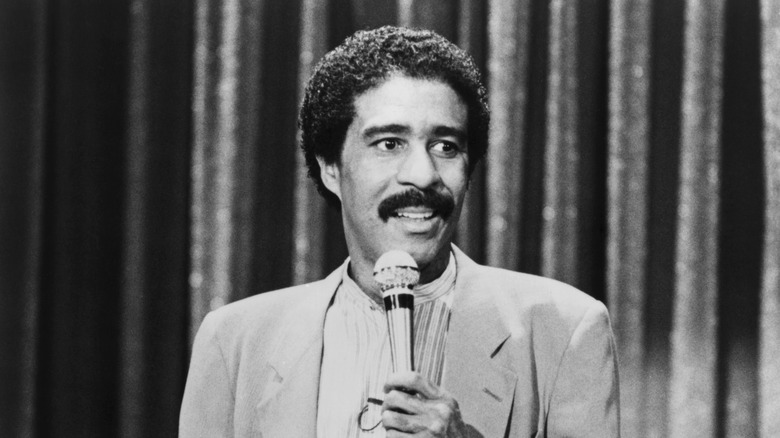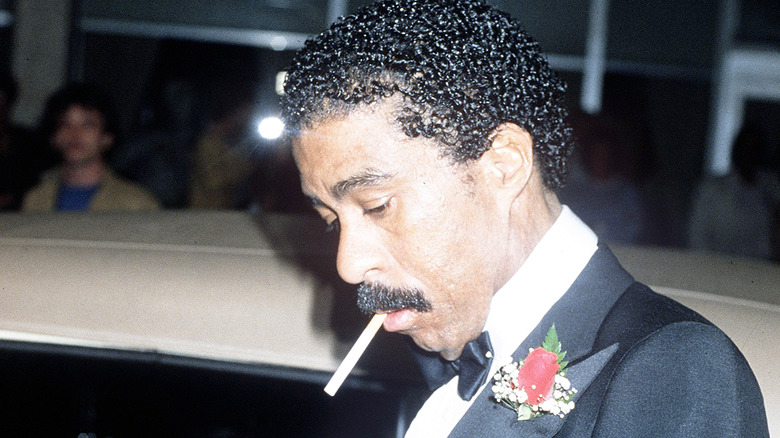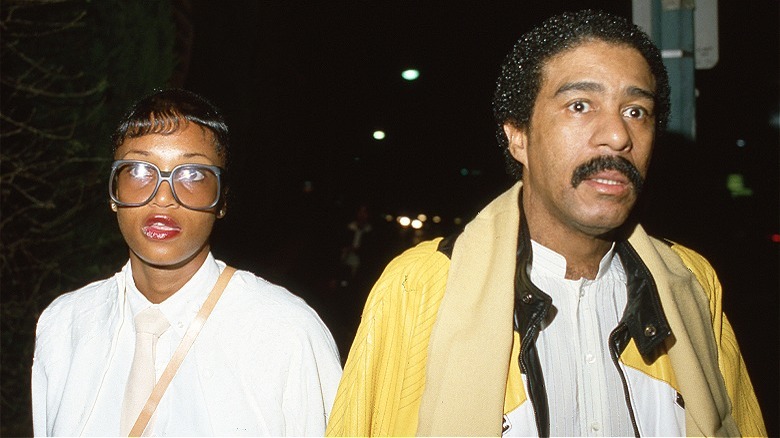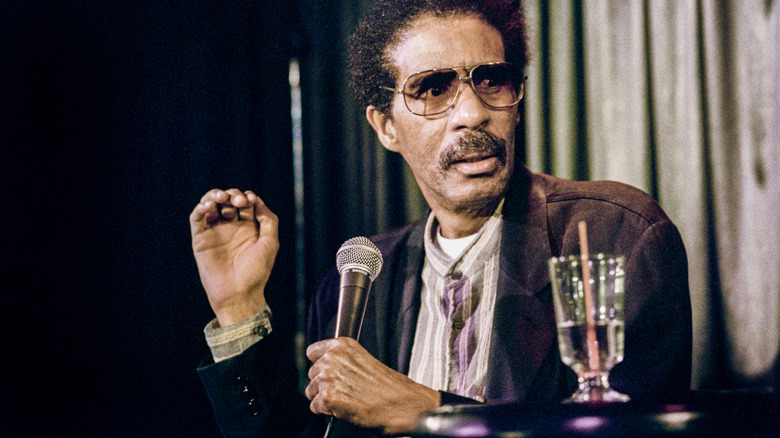The Tragedy Of Richard Pryor Explained
For many comedy aficionados, Richard Pryor was one of the greatest stand-up comedians of all time. With several classic specials to his name and a reputation for being a comic with an uncanny knack for mimicry and voices as well as impeccable timing, he was the recipient of numerous awards, including the prestigious Mark Twain Prize for American Humor. In a statement, Pryor told the crowd of friends, colleagues, and well-wishers: "I am proud that, like Mark Twain, I have been able to use humor to lessen people's hatred" (via Biography).
But Pryor didn't simply have funny bones. Comedian Keenen Ivory Wayans told The New York Times that Pryor "made the blueprint for the progressive thinking of Black comedians, unlocking that irreverent style." The fact is that Pryor's comedy drew heavily from his own life, which was often painful. From his difficult upbringing by his grandmother Marie to his years of addiction as an adult and, later, his chronic ill health, Pryor dealt with many issues that others would be slow to laugh about. Here are the tragedies that characterized Pryor's life and his classic comedy.
Raised in a brothel
Richard Pryor had a fraught early life that had a tangible effect on the comedy he would later produce. Indeed, Pryor was open about his upbringing in his routines, making light of the traumas he suffered.
Pryor was born in Peoria, Illinois, on December 1, 1940, to Gertrude, a sometime bookkeeper, and LeRoy Jr., a boxer who worked various jobs around the country and served for a time in the U.S. military. The two were also involved in LeRoy's mother Marie's brothel business, which at its peak extended to three houses and employed several sex workers, including Pryor's mother. From a young age, Pryor was raised at Marie's brothel, and though Marie, who was often his primary carer, attempted to shield the child from the reality of what was happening around him, he retained some disturbing memories from his early life.
In his autobiography, "Pryor Convictions, and Other Life Sentences," Pryor recalled that he regularly saw his mother going to bed with men other than his father: clients at his grandmother's brothel. He also states that he once made the gruesome discovery of a dead baby in a shoebox, which he supposed was the unwanted offspring of one of the women who worked for Marie.
An abusive childhood
Richard Pryor's grandmother Marie features in a number of his most famous routines, including one bit from his 1979 classic "Richard Pryor: Live in Concert" in which he describes his fear as his grandmother instructs him to fetch a "switch," or slim branch, from a tree near their house for her to beat him with.
Pryor was one of four children raised in Marie's brothel, and in his autobiography he describes how the children were at Marie's mercy throughout their early lives, often catching a beating for minor infractions. Sometimes, adults would instruct the young and trusting Pryor to do things that would lead to him being beaten. In one incident, the phone rang in the house, and Pryor picked up. It was his uncle, Dickie, who told the child to tell Marie that she "ain't the fat hen's a**." Pryor called out the phrase to Marie, who then hit him repeatedly with a belt.
Pryor also recalls an episode in which he was sexually assaulted by a teenager from his neighborhood, and claims that in one incident he was kissed in a sexual manner by a local priest. Shockingly, when he reported this to his grandmother, father, and uncle, the latter two concocted a scheme to use the young Pryor as bait to blackmail the priest and extort money. His grandmother eventually put a stop to the men's scheming and told Pryor to consider that priests are guilty of having human flaws like everyone else.
If you or anyone you know may be the victim of child abuse or has been a victim of sexual assault, contact the relevant resources below:
- Contact the Childhelp National Child Abuse Hotline at 1-800-4-A-Child (1-800-422-4453) or contact their live chat services.
- Visit the Rape, Abuse & Incest National Network website or contact RAINN's National Helpline at 1-800-656-HOPE (4673).
Tortured romances
Richard Pryor was brought up in a sexually charged environment, and as a teenager lost his virginity to the girlfriend of a local pimp named Spinks. Pryor writes in "Pryor Convictions" that Spinks may have intentionally left Pryor and his girlfriend alone and engineered the liaison, with the girlfriend, Penny, guiding Pryor through the experience.
The future comedian claimed to have been scared of women as an adolescent. This may be explained by a sad episode from fourth grade, when Pryor developed a crush on a white school friend. He gifted the girl a toy, which she took home. Her incensed father came to the school the next day and, using a racial epithet, told Pryor to keep away from his daughter. The incident was deeply hurtful and confusing for the young Pryor, who describes the damage it did to his self esteem. Pryor's love life was tumultuous through the years: He was married seven times to five different women, and had seven children with six different women — a history that complicated the matter of who inherited Pryor's money when he died.
Racism in the Army
In 1958, Richard Pryor, who had grown tired of Peoria, volunteered to join the U.S. Army in Chicago and was accepted. He trained at Fort Leonard Wood, Missouri, where he specialized in plumbing but also received combat training, before he was dispatched to an Army camp in Idar-Oberstein, Germany. Though he was initially excited to be traveling so far from home, he was soon brought down to earth by racism at the hands of his fellow soldiers, including a sergeant who used a racial slur during a phone conversation with Pryor before the latter had even arrived at the base.
Once in Germany, Pryor faced segregation, and claims in "Pryor Convictions" that only three bars in the town were willing to accept Black customers, and he faced racial abuse and the threat of violence. Those conditions nearly landed him a serious criminal charge. Things came to a head in a movie theater, when a white soldier offended Pryor and another Black enlistee by laughing at racially charged scenes in the 1959 film "Imitation of Life." It led to a brawl, in which Pryor claims to have stabbed the white soldier several times with a switchblade before fleeing the scene. Eventually, the soldier and the military police caught up with Pryor, and he was sent to jail before being discharged.
Performance anxiety
It was after facing disgrace in the military that Richard Pryor turned toward comedy as a potential career path that he hoped would allow him to work his way out of unemployment. The future star had always enjoyed clowning: He recalled that his first memory of getting a laugh from the people around him was when he slipped in dog poop in front of several family members, and then decided to do it again to relive the reaction.
Pryor often felt victimized by the school system — his teacher failed to defend him when the father of the girl he had a crush on came to berate him, and he was expelled from Catholic school once teachers found out that his family ran a brothel – and he was once thrown out of school by a science teacher who had grown tired of Pryor entertaining his fellow students. However, he was also considered a natural performer by his drama teacher, who nurtured his talents, while another educator even allowed him to perform in front of his class. Pryor became a talented impressionist by mimicking his teachers, friends, and even bullies.
It didn't take long for Pryor to make inroads into the entertainment industry, but despite his ability he was a deeply anxious performer offstage. In his early career, he was a support act for the legendary vocalist Nina Simone. In her autobiography "I Put a Spell on You," Simone recalled having to help Pryor calm his nerves before he performed.
Crashing his career
Throughout the 1960s, Richard Pryor's reputation as a top-class comedian grew. In 1963, he left behind his wife and child to move to New York, where he became a regular fixture at nightclubs in the city. However, his act in the early days was family friendly. His major influences included classic TV comedians like Jerry Lewis, Sid Caesar, and Red Skelton, whose material he used to recite at school. His comedy blueprint was laid out by the now-disgraced Bill Cosby, who at the time was one of the biggest and best-loved Black entertainers on the planet and whose material generally eschewed taboo subjects.
Pryor became a TV star in his own right and was soon booked for spots on "The Tonight Show," "The Ed Sullivan Show," and other shows catering to vast audiences of millions of Americans. However, he grew increasingly uncomfortable with his sanitized act, and under the influence of the incendiary alternative comedian Lenny Bruce, who would talk openly about subjects like sex and social injustice, Pryor re-envisioned his act. At a sold-out show in Las Vegas in 1967, he famously walked onstage, uttered, "What the f*** am I doing here?" and walked off. Pryor later claimed in "Pryor Confessions" that the incident was reflective of a "nervous breakdown." His career briefly stalled, and he found himself returning to small venues. But he came back to comedy reinvigorated by the Black Power movement and willing to share the trauma he had suffered with the world and work it into his act.
Cocaine addiction
Little did Richard Pryor's early audiences know that during almost the entirety of his career he was a heavy user of cocaine, another aspect of his life that he would later discuss openly in his comedy routines. Despite Pryor being raised in poverty and having a troubled early life, biographer Jeff Rovin, author of "Richard Pryor: Black and Blue," claims that the comedian only began using drugs in New York when first building his career, beginning with alcohol before becoming addicted to cocaine.
As Pryor's celebrity grew, cocaine became even more accessible and affordable to him, exacerbating his use. By 1967, when Pryor was living in Hollywood, he was snorting hundreds of dollars worth of high-end cocaine a day, scored from his drug dealer, Dirty Dick. Pryor recalls in "Pryor Convictions" that after one visit to Dick, he got into an altercation with the man working on the front desk of his own apartment building. High and out of control, he punched the man in the face, and was arrested; the man later sued Pryor successfully for $75,000. It was just the first of many incidents in which Pryor would lose control as a result of his addictions.
If you or anyone you know needs help with addiction issues, help is available. Visit the Substance Abuse and Mental Health Services Administration website or contact SAMHSA's National Helpline at 1-800-662-HELP (4357).
Early health issues
Richard Pryor wasn't exactly unusual in the 1970s entertainment industry for his copious use of alcohol and cocaine, but surely he was one of the stars of the era who most publicly suffered the consequences of it. In 1978, when the comedian was in his late 30s, he suffered his first heart attack. The painful episode would, as with most other dark aspects of his private life, become fodder for his show. His famous "Richard Pryor: Live in Concert" performance includes the bit "Heart Attacks," which sees Pryor held hostage by his own heart, to which he gives voice and acts out his heart chastising him for eating too much pork.
He would suffer further heart attacks in later years, and underwent a quadruple bypass as a result of his extensive heart disease. In 2005, when Pryor joined the ranks of comedians who died tragically, the cause of death was reported as being a heart attack.
Surviving an inferno
Though Richard Pryor's drug addiction was taking a toll on his health at a comparatively young age, he continued to take cocaine in the years following his 1978 heart attack. In 1979, he was still a visitor at the home of his drug dealer Dirty Dick, and was introduced to a new method of taking cocaine that would lead to one of the darkest incidents of Pryor's life.
Pryor witnessed Dick "freebasing" a rock of pure cocaine, i.e. smoking it rather than snorting it as Pryor was used to. According to "Pryor Convictions," Dick emerged from his high telling the comedian that he had "seen God," prompting Pryor to begin freebasing. The first time he tried it at his own home, he accidentally started a fire with rum.
The following year, the comedian was freebasing once more when he set himself on fire again. Though family members attempted to smother the flames, he ran from the house ablaze, fled from the property, and was only stopped when police officers intervened. Pryor suffered horrifying burns on 50% of his body. He later claimed that the fire was an intentional suicide attempt.
Domestic violence played out in public
Another very public incident in the life of Richard Pryor occurred on New Year's Day, 1978, and involved an altercation between the comedian and his third wife, Deborah (pictured), whom he had married the previous year. Pryor, Deborah, and two of her friends had spent New Year's Eve drinking at the Pryors' home. Biographer Jim Haskins, author of "Richard Pryor: A Man and His Madness," claims that the party became heated when Pryor learned that his new wife was also sexually involved with at least one of the women who were visiting the house.
"Richard Pryor: Black and Blue" goes into more detail, claiming that the women, siding with Deborah, became the target of Pryor's anger, and the comedian and the women maintained a drunken argument that went on for hours. Shortly after, he chased the women from the house, but instead of letting them leave freely, he jumped in his car and rammed their vehicle several times before returning to the house for his .357 Magnum handgun. Pryor began shooting at the car multiple times, shouting that he was preventing the women from leaving in it. Police arrived, and Pryor, who had anger issues, was arrested.
The incident came months before the death of his grandmother Marie, whose loss, though she had beaten him as a child, Pryor mourned deeply. It coincided with the comedian developing a reputation as an erratic talent to work with, and led to the downturn of his television and movie career, though as usual such trials became his material.
If you or someone you know is dealing with domestic abuse, you can call the National Domestic Violence Hotline at 1−800−799−7233. You can also find more information, resources, and support at their website.
Living with multiple sclerosis
By 1986, Richard Pryor was back cohabitating with his ex-wife Deborah, who had filed for divorce shortly after the comedian had "murdered" her friend's car and terrified the neighborhood on New Year's Day 1978. The pair were in bed at Pryor's house on Maui, Hawaii, when he began to experience flashing lights shooting across his field of vision. They decided to book Pryor, who soon also suffered from numbness in his limbs and stiffness in his fingers and neck, into the Mayo Clinic. After a series of tests, the comedian was diagnosed with multiple sclerosis. He was not yet 50.
In "Pryor Convictions," which was published in 1995, Pryor describes the depression caused by his condition, and claims that it led to suicidal thoughts. Nevertheless, the comedian continued to perform, starring in several movies, and was still doing stand-up in the 1990s, often in a wheelchair, as he was when he was shown in the audience at the Kennedy Center to receive his Mark Twain Prize in 1999.
To learn more about Pryor's life and career, read The Untold Truth of Richard Pryor.
If you or someone you know is struggling or in crisis, help is available. Call or text 988 or chat 988lifeline.org
